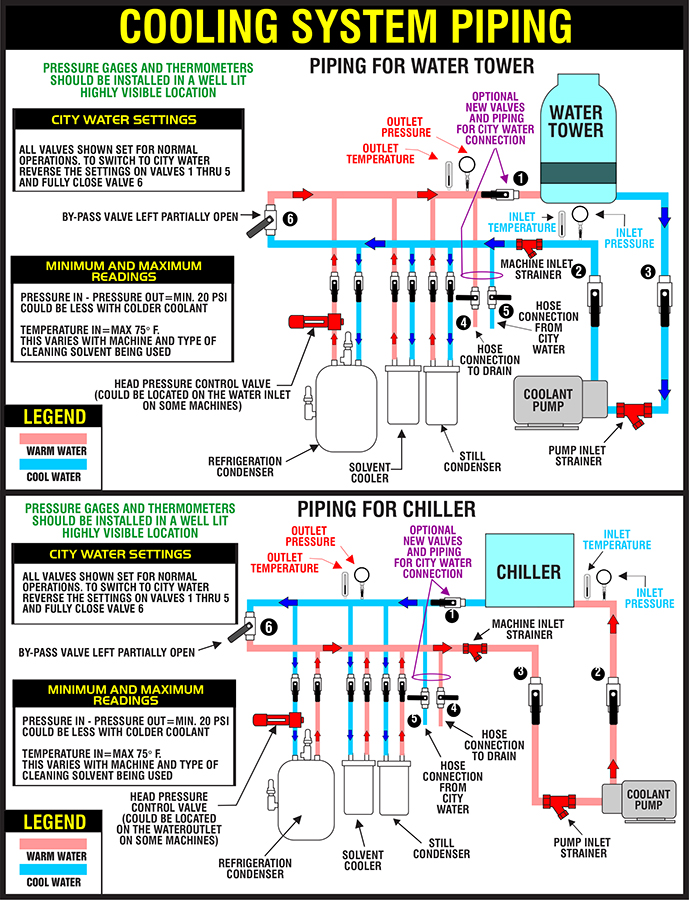With summer upon us, your dry cleaning machines’ cooling system will be under greater stress. It doesn’t matter if you are using a water tower, chiller, or city water for cooling; conditions that weren’t an issue during the cooler months may become problems as the ambient (surrounding) temperature rises. Most of the cooling issues will rear their ugly heads during the drying segment of the dry cleaning cycle.
Drying in the dry cleaning machine is all about moving and transferring heat energy. The media that removes this heat inside the dry cleaning machine is called a refrigerant (usually a member of the Freon family of chemicals). Some coolant (generally water or a water and glycol mixture) is then used to remove the heat from the hot Freon gas, condensing it back to a liquid and transferring the heat to the outside environment.
This condensation process utilizes a device called a REFRIGERATION CONDENSER. This REFRIGERATION CONDENSER changes hot, vapor-rich Freon gas back into liquid Freon, which is constantly recycled during the drying segment of the dry cleaning cycle.
THREE METHODS OF SUPPLYING WATER TO A DRY CLEANING MACHINE’S COOLING SYSTEM
1. CITY WATER- Water from the city main is forced through the dry cleaning machine’s refrigeration condenser by existing city water pressure. The exiting water is then sent down the drain.
2. WATER TOWER—A pump circulates water through the dry cleaning machine’s refrigeration condenser over an evaporative cooling media (it looks like corrugated plastic cubes), which has air forced through it to aid in evaporation, into a sump where the suction inlet of the pump is connected. The water’s evaporation from the media’s surface cools the remaining water, which drops into the sump for recirculation through the dry cleaning machine’s cooling system.
3. CHILLER-Water or a mixture of water and glycol (called a brine) is circulated by a pump through the dry cleaning machine’s cooling system, cooled by a separate refrigeration system, and re-circulated through the dry cleaning machine’s cooling system.
No matter what method is used for cooling and circulating the coolant through the cooling system, the efficiency of the process is dependent on two factors:
A. COOLANT FLOW– the amount of coolant moving through the condenser.
B. HEAT TRANSFER EFFICIENCY- the ability of the condenser coil to move heat to the coolant.
These factors can be easily monitored using pressure and temperature as indicators of what is happening in the coolant system. A pressure gauge and thermometer at the inlet and outlet of the coolant system located near the dry cleaning machine are vital for monitoring the cooling system performance. Let’s look at what the pressure gauge can tell us about the condition of the coolant system. The pump must push enough coolant at the proper pressure through the components that require cooling. In most dry cleaning machines, this cooling system would include the still condenser, refrigeration condenser, and solvent cooler. Unfortunately, there is no hard, fast rule for what the pressure readings should be. The best method for obtaining the “numbers” is to note the inlet and outlet pressure and temperature readings when the dry cleaning machine works properly for future reference. The following are some possible scenarios for different combinations of qualitative data:
1. Inlet pressure high/outlet pressure low:
A. Check for blockage inlet flow path- a clogged Y strainer between the pump and the dry cleaning machine:
B. Heavy scale build up- an accumulation of scale inside the piping and heat exchange surfaces of the dry cleaning machine.
2. Inlet and outlet pressure rapidly changing:
A. Low coolant level in the pumping system.
3. Low inlet/high outlet pressure
A. Open bypass valve on pumping system:
4. Low inlet/low outlet pressure
A. Pump off
B. Clogged inlet strainer
5. High inlet temperature/high outlet temperature:
A. Water tower fan not working/chiller refrigeration system faulty.
B. Pump off
6. Slightly higher than normal inlet temperature/high outlet temperature:
A. Heavy scale build up- an accumulation of scale inside the piping and heat exchange surfaces of the dry cleaning machine.
B. Excessive heat source- still boil over or steam sweep valve open; steam supply valve to steam boost coil or carbon adsorber.
Back to the dry cleaning machine operation- Problems with the cooling system will most likely appear during the dry cycle. More specifically, towards the end of the dry cycle, when the dry cleaning machine goes into cool-down mode. During the drying mode, the heat when the exchanger coil transfers much of the heat from the Freon to the air stream, and only a small portion of the heat load is dumped into the refrigeration condenser. In the cool-down mode, solenoids and/or dampers channel nearly the entire heat load into the refrigeration condenser. This type of problem is indicated by the REFRIGERATION COMPRESSOR entering a high-pressure condition and tripping the REFRIGERATION HIGH-PRESSURE SAFETY SWITCH. On most machines, this would cause an error message on the programmer screen and require a manual reset of the refrigeration high-pressure safety switch. This condition is almost always caused by a clogged Y strainer or excessive scaling inside the refrigeration condenser. There is a HEAD PRESSURE ADJUSTING VALVE on most dry cleaning refrigeration systems, which controls the refrigeration compressor’s head pressure by varying coolant flow to the refrigeration condenser. This valve is adjusted to give sufficient refrigeration head pressure for efficient refrigeration system operation. When scale builds up in the refrigeration condenser, past the point that normal adjustment of the head pressure adjusting valve can compensate for, many dry cleaners mistakenly open the valve wider, believing they have actually fixed something. They have actually “kicked the can down the road” until the REFRIGERATION HIGH-PRESSURE SAFETY SWITCH continual trips, and in the process, they pay a lot of extra money in solvent and energy and possibly damage the refrigeration compressor. The accompanying illustration shows a schematic for a typical cooling water installations use with water towers or chillers, WITH THE ADDITION OF VALVES 1, 2, and 4, which are used when a city water hook-up is included in the installation. This city water hook-up provides an emergency backup for continuing operations when the normal cooling system fails (it will not help if excessive internal scaling is the cause of the problem).


Bruce Grossman
Bruce Grossman is the Chief of R&D for EZtimers Manufacturing. EZtimers is the manufacturer of the new EZ DOSE boiler compound manager and return tank level control which replaces that troublesome ball float valve in the condensate return tank and automatically adds the correct amount of boiler compound to the return tank preventing the oxygen corrosion and scaling. Our SAHARA and DIB-M high purity separator water mister/evaporators provide a thrifty, legal method to get rid of the separator water generated by your dry-cleaning machine. See our Ad in this issue and for further information on EZtimers products visit www.eztimers.com Please address any questions or comments for Bruce to bruce@eztimers.com or call 702-376-6693.

